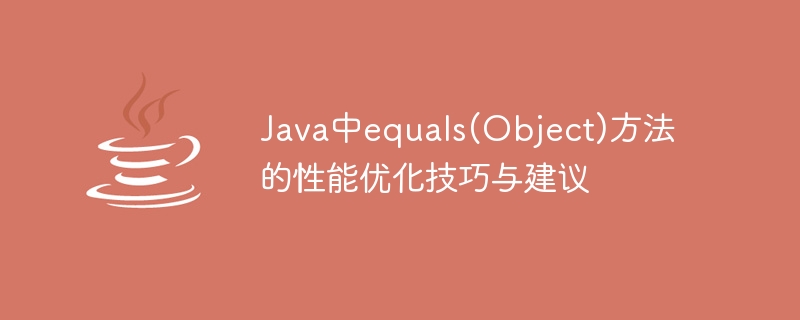Home >Java >javaTutorial >Optimizing the performance of equals(Object) method in Java: Tips and suggestions
Optimizing the performance of equals(Object) method in Java: Tips and suggestions
- PHPzOriginal
- 2023-12-20 09:36:521326browse

The equals(Object) method in Java is a method used to compare whether two objects are equal. In daily development, we often need to use the equals method to compare whether two objects are equal. However, the performance of the equals method may have a certain negative impact on the overall performance of the program. In order to improve the performance of the program, we need to optimize the equals method. This article will introduce some tips and suggestions for optimizing the equals method in Java.
- Use different types of checking methods
The equals method in Java will first check whether the two objects are the same reference, and return true if they are the same reference. This is because if two references point to the same object, they are definitely equal. This check is very fast because there is no need to compare the object's properties.
If the two objects are not the same reference, a more detailed comparison is required. A common approach is to first check whether the two objects are of the same type and return false if not. This check can be achieved by obtaining the class of the object using the getClass() method.
If two objects are of the same type, a more detailed attribute comparison can be performed. At this time, you can use specific attribute comparison methods (such as comparing integers, strings, etc.) or use reflection to compare the attributes of objects. The specific method used depends on the type and number of object attributes.
- Add null judgment
In the equals method, we need to perform null judgment on the incoming parameters. If the parameter passed in is null, false is returned. This is because a null object is definitely not equal to any non-null object.
Adding null judgment can avoid NullPointerException exceptions during the comparison process. In actual use, we often use a simplified writing method to perform null judgment, such as using the isNull method of the Objects class.
- Override the hashCode method
While overriding the equals method, we also need to override the hashCode method at the same time. This is because if two objects are equal, their hashCode values must be equal.
The design principle of the hashCode method is: if two objects are equal, their hashCode values must be equal; if two objects are not equal, their hashCode values should be as unequal as possible. In order to meet this principle, we need to combine the equals method in the hashCode method to compare the properties of the object.
Performance optimization of the hashCode method is also an important issue. A common approach is to cache the hashCode value to avoid repeated calculations. Another approach is to use some common algorithms (such as linked list method, square method, etc.) to calculate the hashCode value.
- Using short-circuit operators
In the equals method, we can use short-circuit operators to improve performance. The short-circuit operator means that when the result of the first expression is determined, subsequent expressions are no longer evaluated.
For example, if we are comparing the properties of two objects, we can first compare whether the references of the objects are equal, and if they are not equal, return false directly to avoid attribute comparison. This saves time and resources on comparisons.
- Using bit operations
When comparing properties of two objects, we can use bit operations to improve performance. Bit operations are a relatively simple and fast operation method.
For example, for the comparison of two integer attributes, we can use the exclusive OR operation (^) to determine whether they are equal. The result of the XOR operation is 0 if the two binary bits are the same, and 1 if they are different. If two integers are equal, their binary bits should be exactly the same and the result of the XOR operation should be 0.
Summary:
The purpose of optimizing the equals method is to improve the performance of the program. We can use different checking methods, add null judgment, override the hashCode method, use short-circuit operators and bit operations and other techniques to achieve optimization effects. In actual development, choosing the appropriate optimization method based on specific needs and data types can improve the operating efficiency of the program.
The above is the detailed content of Optimizing the performance of equals(Object) method in Java: Tips and suggestions. For more information, please follow other related articles on the PHP Chinese website!
Related articles
See more- The key components that affect the performance of a computer are
- What aspects of computer performance should you look at?
- How to add elements to an array in javascript
- Practical Word Tips Sharing: How to quickly merge multiple documents into one document
- What are the six major performance indicators of performance testing?

